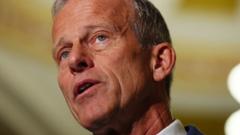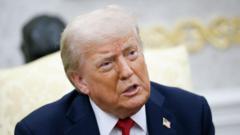Between July and September, India's economy reported a slowdown to 5.4%, which falls below the Reserve Bank of India's forecast. Despite remaining robust compared to developed nations, this figure has raised concerns among economists regarding the sustainability of India's rapid growth trajectory. The decline is attributed to various factors, including weakened consumer demand, sluggish private investment, and a reduction in government spending, which has previously bolstered economic activity. Additionally, India’s goods exports have struggled to gain traction, standing at a modest 2% in 2023.
India's Economy Faces Slowdown Amidst Signs of Strain

India's Economy Faces Slowdown Amidst Signs of Strain
India's latest GDP figures reveal troubling signs for the world's fastest-growing major economy, as growth dips to a seven-quarter low.
Consumer behavior reflects the ongoing challenges, as fast-moving consumer goods companies report lackluster sales. Urban wages, a barometer for overall economic health, have also decreased. Following this trend, the RBI has adjusted its growth forecast to 6.6% for the financial year 2024-2025 after the bleak economic indicators surfaced. Economist Rajeshwari Sengupta underscores that while the GDP figures alarmingly signal a demand issue, Finance Minister Nirmala Sitharaman maintains positivity, presenting the decline as a temporary result of prioritizing fiscal restraint during an election quarter.
Despite current economic hurdles, such as stagnant wages, weakened urban demand, and the impacts of climate change on agriculture, Sitharaman remains optimistic about India's future growth. However, critics highlight the central bank’s tight monetary policy, suggesting that sustained high-interest rates may restrain both consumer and business spending, intensifying growth limitations.
Amid rising inflation—recorded at 6.2% in October—largely fueled by high food prices, the central bank's current stance is under scrutiny. Economists note that simply lowering interest rates will not stimulate demand unless there’s a resurgence in consumer activity. A two-speed economy is apparent in India, with traditional sectors stagnating while the new economy, characterized by burgeoning sectors like services, grapples with diminished consumer spending.
Amid these conflicting signals, India’s average tariffs have risen, which further complicates trade competitiveness. Some economists warn that ongoing efforts to stabilize the rupee at the potential expense of alleviating liquidity could hinder export growth. Experts argue that a focus on optics rather than effective economic policies might jeopardize the country’s long-term prosperity.
As the government strives to remain upbeat, acknowledging the strength of banks and foreign reserves, skepticism persists regarding India's ability to fulfill its ambitious growth narrative. Innovative strategies targeting wage increases through employment initiatives and reducing trade barriers may be crucial for revitalizing investment and consumption to ensure long-lasting economic stability.
Despite current economic hurdles, such as stagnant wages, weakened urban demand, and the impacts of climate change on agriculture, Sitharaman remains optimistic about India's future growth. However, critics highlight the central bank’s tight monetary policy, suggesting that sustained high-interest rates may restrain both consumer and business spending, intensifying growth limitations.
Amid rising inflation—recorded at 6.2% in October—largely fueled by high food prices, the central bank's current stance is under scrutiny. Economists note that simply lowering interest rates will not stimulate demand unless there’s a resurgence in consumer activity. A two-speed economy is apparent in India, with traditional sectors stagnating while the new economy, characterized by burgeoning sectors like services, grapples with diminished consumer spending.
Amid these conflicting signals, India’s average tariffs have risen, which further complicates trade competitiveness. Some economists warn that ongoing efforts to stabilize the rupee at the potential expense of alleviating liquidity could hinder export growth. Experts argue that a focus on optics rather than effective economic policies might jeopardize the country’s long-term prosperity.
As the government strives to remain upbeat, acknowledging the strength of banks and foreign reserves, skepticism persists regarding India's ability to fulfill its ambitious growth narrative. Innovative strategies targeting wage increases through employment initiatives and reducing trade barriers may be crucial for revitalizing investment and consumption to ensure long-lasting economic stability.


















